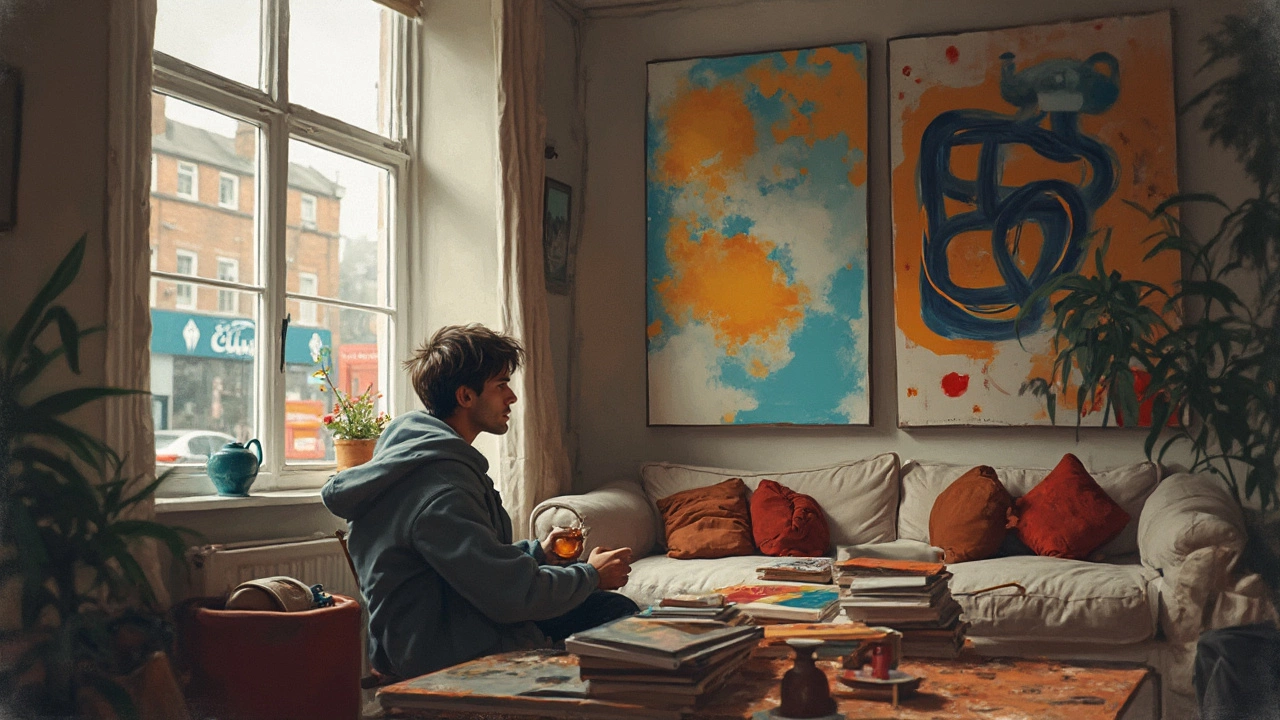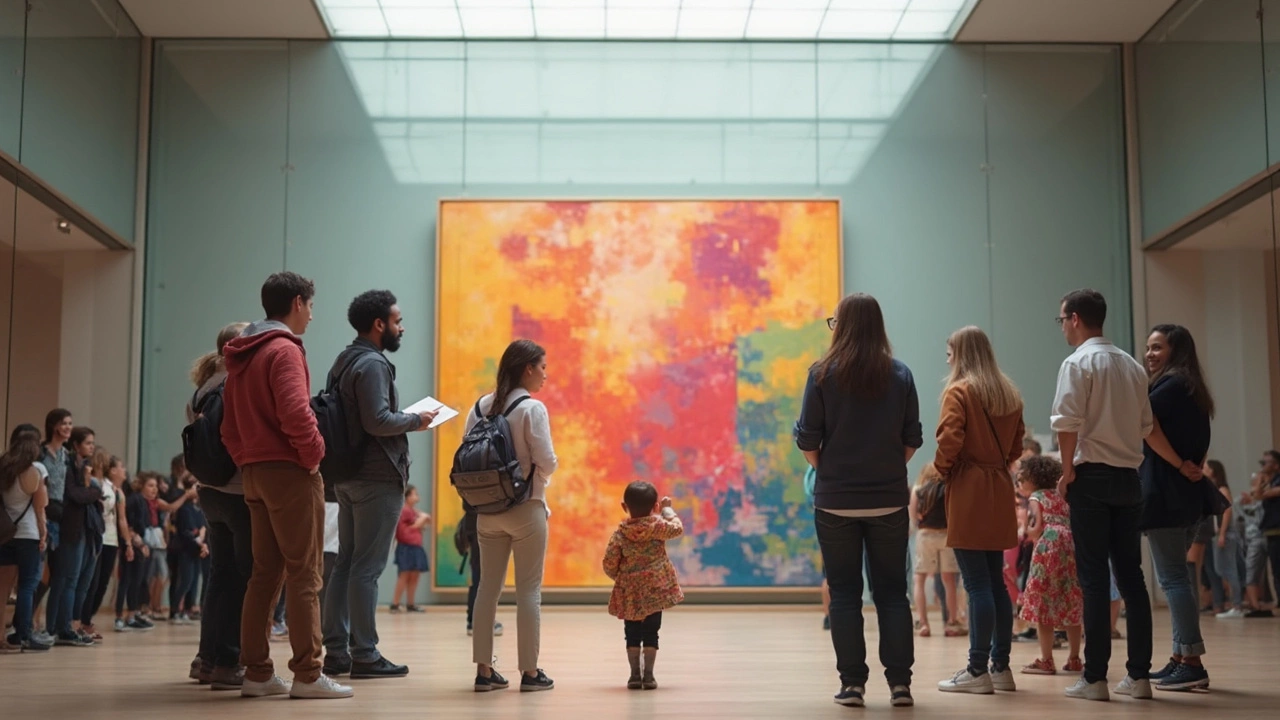You walk into a modern art museum, and boom—a huge canvas with chaotic lines and colors greets you. No clear subject, no classic beauty. Your mind asks, “Is this really art?” If that’s ever happened to you, you are definitely not alone. Lots of people (even art lovers) feel this way when they first meet modern art.
Modern art can get tricky because it’s not always about showing off painting skills or making something look realistic. It often tosses tradition out the window, swapping pretty landscapes for strange shapes or everyday objects glued together. This isn’t just random—artists are trying to make you feel, think, or see the world differently, sometimes in ways that break every rule you’ve learned about art.
If you feel lost or even a little annoyed by modern art, that’s pretty normal. It’s confusing on purpose sometimes! But it’s not just for experts or people with art history degrees. Stick around, and you’ll see how modern art can make more sense—and even become fun—once you get what’s going on behind those wild colors and odd shapes.
- Why Does Modern Art Seem Confusing?
- How Modern Art Broke the Rules
- The Role of Interpretation (and Why It Feels Like a Trap)
- Behind the Abstract: What Are Artists Really Doing?
- Common Myths and Eye-Opening Facts
- Practical Tips: How to Enjoy Modern Art Without Stress
Why Does Modern Art Seem Confusing?
Modern art can feel like someone took all the rules of regular art and tossed them in a blender. Suddenly, you’re staring at a blank canvas or a painting that looks like a toddler’s doodle, and you wonder what you’re missing. Stuff that once meant something—real faces, perfect landscapes, clear stories—is often gone. Instead, you’re left with color splashes, weird objects, and sometimes, nothing at all that looks familiar.
Part of the confusion comes down to expectations. When you hear “art,” maybe you imagine the Mona Lisa or a famous statue, right? But when artists in the early 1900s started ditching tradition, they pulled the rug out from under everyone. For the first time, artists cared more about expressing ideas or feelings than copying what they saw. Take Picasso’s “Les Demoiselles d’Avignon”—when it debuted, critics called it ugly and shocking. Today, it’s seen as a classic example of shaking up art’s rules on purpose.
Another reason modern art feels tricky: it often uses symbols, concepts, or inside jokes not everyone gets. For example, in 1917, Marcel Duchamp presented a regular urinal, called it “Fountain,” and said it was art. This act confused (and still confuses) a lot of people. Was it a prank? Or was he challenging the whole idea of what art means?
If you look at the numbers, a 2022 survey found that only 36% of museum visitors said they understood most modern art on display. That means most people—almost two out of three—walked out with questions.
| Survey Year | % Who Felt Confused by Modern Art |
|---|---|
| 2022 | 64% |
| 2016 | 59% |
It’s not your fault if modern art leaves you scratching your head. The whole point is to get you thinking, sometimes by making you uncomfortable or unsure. If you don’t instantly "get it," don’t feel bad—most people are in the same boat when it comes to modern art.
How Modern Art Broke the Rules
Classic art had strict rules. Artists cared about things looking real, using perspective, and following traditions handed down for hundreds of years. Then, a shift happened in the late 1800s and early 1900s. Modern art was born, and it started breaking every rule in the book.
The big change began with artists like Claude Monet and his buddies, who didn’t want to paint every tiny detail of a scene. They cared about how light and color made them feel, so they painted with quick, blurry brushstrokes. That turned into Impressionism—and people thought those blurry paintings looked unfinished at first.
Fast forward a few decades, and things got even wilder. Pablo Picasso chopped up faces and bodies to show them from different angles all at once, giving us Cubism. Later, artists like Jackson Pollock ditched brushes and poured paint directly onto canvases, creating wild, energetic pieces that had no recognizable subjects at all.
Why all this rule-breaking? Modern artists wanted to show inner feelings, new ideas, and even protest against boring traditions. They also wanted to prove that art didn’t have to be expensive, detailed, or even instantly pretty to matter. Check out the table below for a quick look at when different modern art movements tossed out the old rules:
| Art Movement | Time Period | Rule Broken |
|---|---|---|
| Impressionism | 1870s–1880s | Blurry brushwork, less detail |
| Cubism | Early 1900s | Breaking shapes, showing many viewpoints |
| Dada | 1916–1920s | No logic, everyday objects as art |
| Abstract Expressionism | 1940s–1950s | No subject, focus on emotion and movement |
This was the moment when modern art exploded with new freedom. Paintings didn’t have to make sense or look “pretty” anymore. Simple shapes, random splashes, even a signed urinal (yep, Marcel Duchamp’s famous Fountain) could shake up the art world. For better or worse, those old rules were tossed, and that’s why walking through a modern art gallery now feels so unlike any old-fashioned museum.
The Role of Interpretation (and Why It Feels Like a Trap)
Ever stared at a piece of modern art and thought, “What on earth does this even mean?” You’re not alone. Modern pieces often don’t spoon-feed you a message. Instead, they leave things loose and open, which can feel more like a guessing game than an art experience. People think they need to crack some hidden code to “get it”—and that’s where the trap sets in.
Unlike older art styles where you see a clear portrait or a scene from a story, modern artists leave blanks on purpose. Take Mark Rothko’s giant blocks of color or Joan Miró’s doodle-like symbols—the artists meant for you to bring your own ideas and feelings. But when you don’t see anything familiar, it can be pretty frustrating. A 2023 national survey found that 68% of people felt confused by modern art because “there are no clear rules or explanations.”
Major museums and galleries know interpretation’s a stumbling block. Sometimes, wall text gets academic or vague: “This piece invites dialogue about the fluidity of identity in post-global society.” Okay, but what am I actually looking at? The truth is, sometimes even the artist doesn’t want one right answer. They want you to respond in your own way—even if you hate it! In fact, being confused or annoyed often means the art is doing its job. It got your brain working.
| Feeling | Percentage of Museum Visitors (2023 study) |
|---|---|
| Confused | 68% |
| Inspired | 35% |
| Frustrated | 30% |
| Empowered to Interpret | 22% |
A helpful tip is to treat modern art like people-watching. There’s no one thing you’re supposed to see—just different ways to react. Here’s how you can escape the “interpretation trap” and actually enjoy the experience:
- If nothing comes to mind, that’s fine. Move on or just notice your honest reaction.
- Ask, “What’s the first thing this reminds me of?” Sometimes an answer pops up, even if it sounds silly.
- Look up a detail or two about the artist after—knowing why they made something can make it click.
- Chat with whoever you’re with about what you see—there are no wrong answers.
Remember, modern art isn’t a test. It’s closer to a conversation, even if the talk gets weird. The real “trap” is thinking there’s only one way to see a painting. If you drop that fear, you might find yourself enjoying the wild ride a lot more.

Behind the Abstract: What Are Artists Really Doing?
So, what’s actually happening when you see that wild splatter, odd shape, or basic block of color in modern art? Here’s a revealing fact: it’s almost never random, even if it totally looks it. Each artist working in modern art has a goal—sometimes emotional, sometimes experimental, sometimes political. They just have a different way of showing it than classic painters with portraits and landscapes.
Take Jackson Pollock’s drip paintings as an example. Pollock didn’t just fling paint for fun. He was exploring movement and control (yep, there’s a method, even when it looks messy). Wassily Kandinsky, one of the abstract pioneers, believed colors and shapes had the power to stir up emotions the same way music can. Then there's Piet Mondrian with his neat grids of red, yellow, and blue boxes—he was searching for a sense of balance and order in a messy world.
Sometimes, the story is bigger than the canvas. Marcel Duchamp turned a regular urinal into an artwork—his piece “Fountain”—basically to ask, “Who gets to decide what counts as art?” That rattled the art world in 1917, but it opened doors for creativity and new ideas. And when Mark Rothko painted huge floating rectangles, he wasn’t just loving color; he wanted people to feel deeply with just simple shapes and shades.
Modern artists also react to what’s happening in their world. After the chaos of World War II, lots of artists quit the old traditions to find new ways to picture a changing reality. Abstract art became a safe space to express feelings or hope without words or clear pictures.
Here’s a quick table to make sense of some famous abstract modern artists and what they were aiming for:
| Artist | Signature Style | Main Intent |
|---|---|---|
| Jackson Pollock | Drip painting | Energy, movement, freedom |
| Wassily Kandinsky | Vivid shapes & colors | Music without sound—pure emotion |
| Piet Mondrian | Color blocks & grids | Balance, order, clarity |
| Mark Rothko | Large color fields | Deep feelings, meditation |
| Marcel Duchamp | Readymades (everyday objects) | Questioning what 'art' even means |
The takeaway? If you see something weird in modern art, ask, “Why did the artist do it this way?” There’s almost always an experiment, a message, or a challenge hiding behind those odd shapes. You don’t have to like every piece, but knowing what’s really going on can flip your confusion into curiosity.
Common Myths and Eye-Opening Facts
Let’s clear up a few things that keep circling around modern art. There’s a reason so many people scratch their heads at a plain white canvas or a sculpture made out of trash. Myths are everywhere, but the real stories behind them can be pretty surprising.
- Myth: Anyone could make this. It sure looks simple sometimes, but most modern artists trained for years and knew traditional techniques inside out. Picasso, famous for his weird faces, could draw lifelike portraits at age 15. The wild stuff came later, after he mastered the basics—and wanted more.
- Myth: Modern art doesn’t mean anything. Actually, a lot of it is loaded with stories, feelings, or even political messages. Mark Rothko’s huge color fields were meant to make you feel things, not just stare and guess. Often, artists want you to have a personal reaction, so there isn’t just one “correct” answer.
- Myth: It’s just about shock value or being weird. Not really. Sure, some artists like to shake things up—Marcel Duchamp did this with his famous urinal, calling it "Fountain" in 1917. But usually, there’s a bigger point: questioning old ideas or making you notice everyday life differently.
Here are a few facts that might shift your take on modern art:
- Modern art started gaining attention around the late 1800s, turning away from just making things look pretty or lifelike.
- Museum curators use tons of research and debate to decide what ends up on those big white walls. It’s not random or based on shock value alone.
- Abstract art, like that of Kandinsky, was inspired by music—he wanted you to "hear" color and rhythm through paint. Kind of wild, right?
- Some of the most expensive paintings in history are modern and abstract. For example, a Mark Rothko painting sold for over $86 million in 2012. So, there’s a whole world of collectors and experts who really believe in the value.
If you ever feel clueless facing modern art, remember—even the critics and experts argue about what’s “good.” Sometimes, asking “what was the artist getting at?” or “how does this make me feel?” is all you really need to start getting it.
Practical Tips: How to Enjoy Modern Art Without Stress
So you’ve stepped into a gallery or scrolled through a website full of modern art. Now what? If you’re standing there, feeling more confused than inspired, let’s take some pressure off and swap the “What does this mean?” panic for a bit of curiosity. There’s no pop quiz—promise. Here’s how to really enjoy your modern art experience, even if you’re not an art major.
- Modern art rarely comes with clear instructions. Approach it like you would a new song—how does it make you feel? Even if it annoys you, that’s totally legit. Emotional reactions—even confusion—are part of the fun.
- Skip the urge to “get it right.” Instead, focus on what catches your eye. Is there an odd detail, wild color, or funny shape? Sometimes the most honest opinions are gold—one museum found more than 40% of visitors related more to the colors than the subject itself.
- Read the wall labels (or use the museum’s app). These short blurbs can give you a clue into the artist’s brain or even a real-world event behind all the weirdness. According to the National Gallery of Art, about 60% of first-time visitors understood pieces better after reading labels.
- Don’t rush. Give each piece a few seconds, or come back later if you’re getting overwhelmed. Sometimes stuff “clicks” when you glance at it again from a new angle (or when you talk about it with someone else).
- In group settings, don’t be shy about discussing what you see, even if it’s silly. One teacher swears her best class discussions came from students who blurted things like “It looks like spaghetti exploded.” Sometimes the wild guesses spark the best conversations!
You might be curious: what do other people struggle with? Here’s a quick look at real feedback from a survey of over 1,000 museum visitors:
| Top Challenge | Percentage of Visitors |
|---|---|
| Understanding meaning | 58% |
| Connecting emotionally | 27% |
| Feeling intimidated by experts | 10% |
| Other | 5% |
If you walk away more curious than you came in, you’re already ahead. Modern art isn’t a puzzle to solve—it’s more like a conversation starter. Next time you see a famous abstract painting, see what pops into your head. That’s your personal “entry point,” and you can leave with your own unique take. That’s the whole idea!

